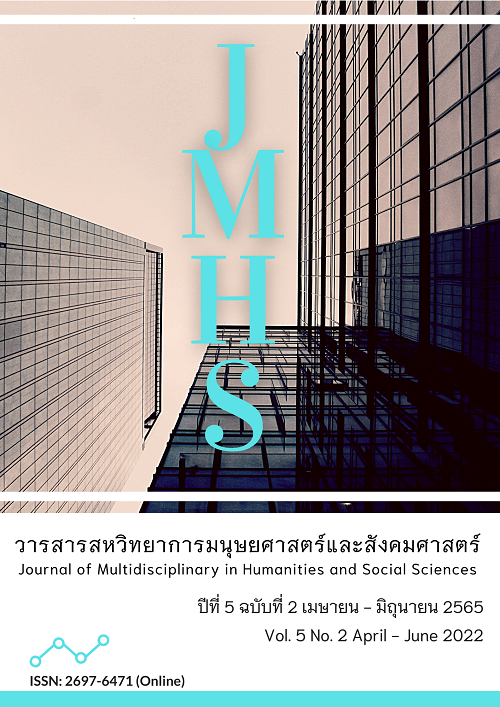A Study Important Principles in the Avijjaya Sutta That Are to The Practice of Vipassana Bhavana
Main Article Content
Abstract
The objectives of this article were 1) to study the content and important Buddhist teaching found in the Avijja Sutta and 2) to study the important teachings relating to insight meditation practice in the Avijja Sutta. It was documentary research by studying data from Theravada Buddhist scriptures and documents related then summarized, analyzed, and compiled in descriptive style. The results of the research revealed that the teaching found in the Avijja Sutta relating to insight meditation practice reveals that yogis who practice insight should avoid ignorance, which is the subject of all unwholesome deeds, consisting of Ahirika or shamelessness, which is an Ahirikacetasika refers to the immoral consciousness without fear of wrong deeds, Anottappa or the fear of sin. Anottappacetasika is the mental state of not being afraid of any wrong deeds and wrong paths consisting of eight paths such as Yogis’ wrong practice, for example, wrong view on fruitless giving and worships and so on. In addition, the Buddha taught the right knowledge or Vijja as the president of all wholesome consciousness consisting of Hiri or shame and Ottappa or fear of dreads, and the right path called Sammamagga. Yogis who practice insight should cultivate the Eightfold Path, for example, yogis who practice insight should conduct the right view, which is the president of all the other noble paths. When it arises, the other noble paths surely follow. This is an important teaching for Vipassana meditation practice because it leads to the cessation of suffering known as Dukkhanirodhagaminipatipada.
Article Details

This work is licensed under a Creative Commons Attribution-NonCommercial-NoDerivatives 4.0 International License.
Views and opinions appearing in the Journal it is the responsibility of the author of the article, and does not constitute the view and responsibility of the editorial team.
References
จิรพร ชีวะธรรม และ อุทัย สติมั่น. (2564). วิเคราะห์การพัฒนาชีวิตตามหลักธรรมที่ปรากฏในพระไตรปิฎก. วารสาร มจร บาฬีศึกษาพุทธโฆสปริทรรศน์, 7(1), 96-106.
พระครูพิพิธวรกิจจานุการ (มานิตย์ เขมคุตฺโต). (2561). ลักขณาทิจตุกะ ในการเจริญวิปัสสนา. กรุงเทพฯ: ประยูรสาส์นไทย การพิมพ์.
พระธรรมธีรราชมหามุนี (โชดก ญาณสิทฺธิ). (2538). คำบรรยายเรื่องวิปัสสนากรรมฐาน เล่ม 7-8-9. (พิมพ์ครั้งที่ 2). กรุงเทพฯ: สหธรรมิก.
พระพรหมคุณาภรณ์ (ป.อ. ปยุตฺโต). (2551). พจนานุกรมพุทธศาสน์ ฉบับประมวลศัพท์. (พิมพ์ครั้งที่ 12). กรุงเทพฯ: โรงพิมพ์มหาจุฬาลงกรณราชวิทยาลัย.
พระพรหมคุณาภรณ์ (ป.อ. ปยุตฺโต). (2554). พจนานุกรมพุทธศาสตร์ ฉบับประมวลธรรม. (พิมพ์ครั้งที่ 19). กรุงเทพฯ: สหธรรมิก.
พระภัทรชัยญกรณ์ อูดสวย. (2564). การบริหารการศึกษาตามหลักพุทธธรรมของโรงเรียนตำรวจตระเวนชายแดน. วารสารนวัตกรรมการจัดการศึกษาและการวิจัย, 4(3), 83-92.
พระมหากิตติณัฏฐ์ สุกิตฺติเมธี. (2564). การวิเคราะห์แนวทางงดเว้นจากความเสื่อมในปราภวสูตร. วารสารสหวิทยาการมนุษยศาสตร์และสังคมศาสตร์, 4(1), 84-95.
พระมหาสุบิน สุนฺทรธมฺโม และ พระมหาบุญศรี ญาณวุฑฺโฒ. (2564). ศึกษาการปฏิบัติวิปัสสนาภาวนาในอัจฉราสูตร. วารสาร มจร บาฬีศึกษาพุทธโฆสปริทรรศน์, 7(1), 123-134.
พระสมชาย บัวแก้ว, พระมหาบุญศรี วงค์แก้ว และ สุเชาวน์ พลอยชุม. (2564). อภิสมาจาร: กระบวนการพัฒนาบุคลิกภาพตามแนวพระพุทธศาสนา. วารสารศิลปการจัดการ, 5(3), 895-907.
พระพุทธโฆสเถระ. (2554). คัมภีร์วิสุทธิมรรค. (สมเด็จพระพุฒาจารย์ (อาจ อาสภมหาเถร), ผู้แปล). (พิมพ์ครั้งที่ 10). กรุงเทพฯ: ธนาเพรส.
มหาจุฬาลงกรณราชวิทยาลัย. (2539). พระไตรปิฎกภาษาไทย ฉบับมหาจุฬาลงกรณราชวิทยาลัย. กรุงเทพฯ: โรงพิมพ์มหาจุฬาลงกรณราชวิทยาลัย.
ศุภวรรณ การุญญะวีร์. (2564). การบริหารจัดการแหล่งเรียนรู้ภายในสถานศึกษาตามหลักสัปปายะ 7 วิถีใหม่. วารสารนวัตกรรมการจัดการศึกษาและการวิจัย, 4(3), 75-82.
สมเด็จพระพุทธโฆษาจารย์ (ป. อ. ปยุตฺโต). (2562). พุทธธรรม ฉบับปรับขยาย. (พิมพ์ครั้งที่ 22). กรุงเทพฯ: มหาวิทยาลัยเอเชียอาคเนย์.
สุชาดา ทองมาลัย ประเวศ อินทองปาน และ ธเนศ ปานหัวไผ่. (2561). วิเคราะห์ความสัมพันธ์ของการปฏิบัติสมถภาวนาและวิปัสสนาภาวนาต่อการบรรลุธรรม. วารสารมนุษยศาสตร์, 25(2), 376-409.
สุภีร์ ทุมทอง, พระเทพสุวรรณเมธี, พระมหาวัฒนา ปญฺณาปทีโป. (2564). การศึกษาวิเคราะห์รูปแบบการอธิบายพระพุทธพจน์ตามแนวเนตติปกรณ์สำหรับนิสิตบัณฑิตศึกษา วิทยาเขตบาฬีศึกษาพุทธโฆส นครปฐม.วารสาร มจร บาฬีศึกษาพุทธโฆสปริทรรศน์, 7(1), 78-94.
อุไรพร ประชาบุตร และ วิไลศักดิ์ กิ่งคำ. (2564). ศึกษาความสัมพันธ์ระหว่างอานาปานสติกับไตรลักษณ์ในคัมภีร์พระพุทธศาสนาเถรวาท. วารสาร มจร บาฬีศึกษาพุทธโฆสปริทรรศน์, 7(2), 1-12.
Chanthathong, S. (2021). The Significance of the Right View (Sammaditthi) in Theravada Buddhism. Journal of International Buddhist Studies, 12(1), 61-70.
Damnoen, P. S., Chaiworamankul, Y., Thammawatsiri, P. A., & Soontrondhammanitus, P. (2021). Buddhist Ethics and the way of Living in Daily Life: An Analysis of Genital Malfeasances (Kamesumicchacara). Turkish Journal of Computer and Mathematics Education, 12(8), 2943-2948.
Tan, C. C., & Damnoen, P. S. (2020). Buddhist Noble Eightfold Path Approach in the Study of Consumer and Organizational Behaviors. Journal of MCU Peace Studies, 8(1), 1–20.


